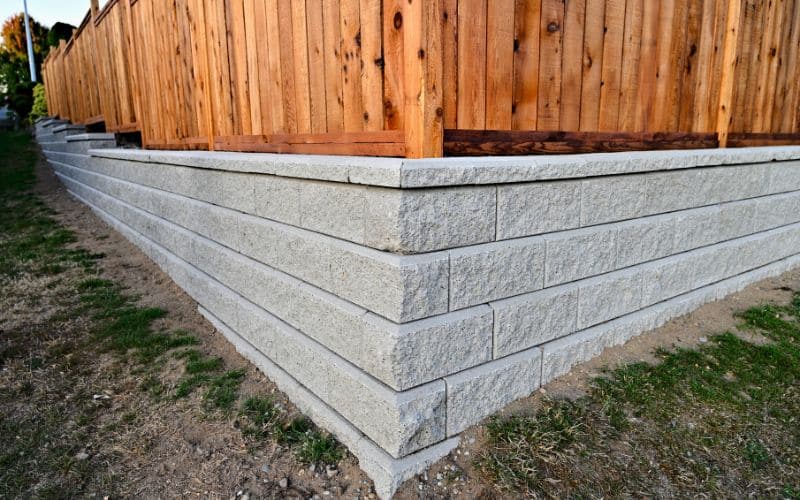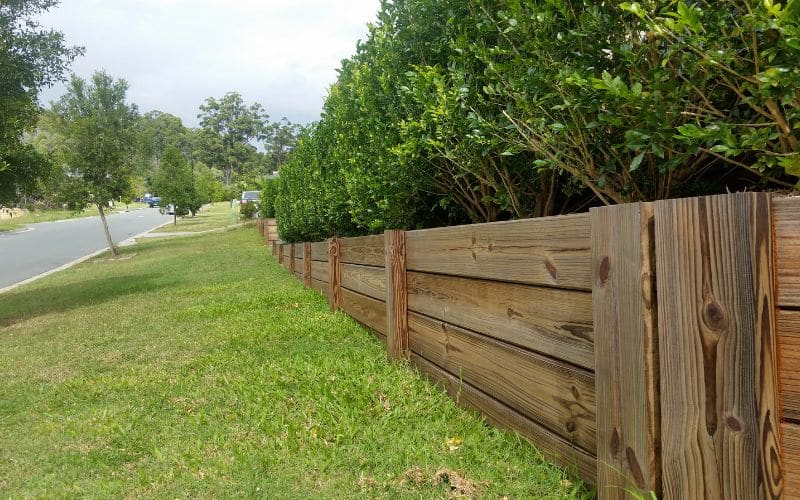
The Great Debate – Timber vs. Concrete Block Retaining Walls
The retaining wall—the unsung hero of landscapes far and wide. Whether you’re a homeowner wrestling with a sloping yard or a landscaper sculpting the earth into a work of art, one question looms large: Timber or concrete block? It’s a choice that can make or break your outdoor space, both in terms of aesthetics and longevity. So, which material will serve you best in the long run? Buckle up, because we’re about to delve into the nitty-gritty of this age-old debate.
What Factors Affect the Longevity of a Retaining Wall?
The lifespan of a retaining wall isn’t just a matter of picking the right material; it’s a complex interplay of various elements that can either extend or shorten its years of service. Let’s break it down:
- Type of Soil: The kind of soil you’re dealing with—be it sandy, loamy, or clayey—can significantly impact the wall’s stability. Some soils drain well, reducing pressure on the wall, while others can become waterlogged, increasing the risk of collapse.
- Quality of Construction: A poorly constructed wall, regardless of material, is a ticking time bomb. Proper engineering, including the use of geogrids or tiebacks for added stability, can make all the difference.
- Drainage: This can’t be stressed enough. Proper drainage systems, such as weep holes and French drains, are essential to divert water away from the wall. Poor drainage can lead to water accumulation, which increases pressure and can cause rot in timber walls or even cracks in concrete ones.
- Climate: Extreme weather conditions, from heavy rainfall to freeze-thaw cycles, can take a toll on your retaining wall. Material that can withstand these conditions will naturally last longer.
- Maintenance: Regular inspections for signs of wear and tear, like cracks or rot, can help you address issues before they become major problems. A well-maintained wall can add years to its lifespan.
- Material: Last but not least, the material itself—be it timber, concrete block, or something else—comes with its own set of pros and cons, which we’ll delve into later.
Why Choose Timber for Your Retaining Wall?
Timber retaining walls have long been a favorite in the world of landscaping, and it’s easy to see why. With their natural aesthetic and rustic charm, they effortlessly blend into almost any outdoor setting. But beyond their good looks, what makes timber a worthy contender in the retaining wall arena?
- Ease of Installation: One of the standout advantages of timber is its ease of installation. Unlike concrete blocks, which may require specialized equipment or expertise, timber walls can often be a DIY project for those with basic carpentry skills.
- Aesthetic Versatility: Timber offers a range of looks, from the rugged and rustic to the polished and refined, depending on the type and finish of the wood. This flexibility allows you to tailor the wall to your specific design vision.
- Environmental Benefits: Timber is a renewable resource, and using responsibly sourced wood can make your project more eco-friendly.
- Cost-Effectiveness: Generally speaking, timber can be less expensive than other materials like concrete or stone, especially if you’re willing to put in a little sweat equity and build it yourself.
- Lifespan Factors: Now, let’s talk longevity. The lifespan of a timber retaining wall can vary widely, depending on several factors. The type of wood is crucial—pressure-treated wood, for instance, is more resistant to rot and insects. Regular maintenance, like sealing, can also extend its life.
- Climate Considerations: Timber may be better suited for certain climates. In areas with less moisture, the risk of rot decreases, potentially adding years to your wall’s life.
What Type of Wood is Best for a Long-Lasting Retaining Wall?
Choosing the right wood for your retaining wall is crucial. Get it wrong, and you could face issues like rot or insect damage. Here’s a quick guide to help you make an informed choice:
- Pressure-Treated Wood: The go-to option, known for its rot and insect resistance.
- Grades Matter: Opt for higher-grade lumber for increased durability and lifespan.
- Cedar and Redwood: Naturally rot-resistant but can be pricier and less available.
- Hardwoods: Durable but expensive, think oak or teak.
- Reclaimed or Composite Wood: Eco-friendly options with varying longevity.
- Climate Considerations: Choose wood that suits your local weather conditions.
- Maintenance: Different woods require varying levels of upkeep.
- Cost vs. Longevity: Investing in quality wood can save you money in the long run.
Pressure Treated Wood: Is It Worth the Investment?
If longevity is your goal, pressure-treated wood is a solid choice for your timber retaining wall. While it may cost a bit more upfront, the investment can pay off in the long run, potentially adding years to the lifespan of your wall.

Concrete Block Retaining Walls: The Alternative to Wood
If timber isn’t your cup of tea, concrete block retaining walls bring their own set of perks to the table. Known for their durability and versatility, these walls are a robust alternative. One of their standout features? They’re impervious to rot, making them a particularly strong contender in regions prone to wet weather. Plus, with a variety of designs and finishes available, you can achieve a look that’s both functional and stylish.
How Does Drainage Impact the Lifespan of Retaining Walls?
We’ve touched on this before, but it bears repeating: Drainage is key. Whether you opt for a wood retaining wall or a concrete block structure, poor drainage can lead to a shorter lifespan and potential failure. Make sure to incorporate proper drainage solutions like weep holes or drainage pipes.

Pros and Cons of Wood vs. Concrete Block Retaining Walls
So, you’re torn between wood and concrete block? Let’s break it down:
- Wood:
- Pros: Natural look, easier installation
- Cons: Potential for rot, may require more frequent maintenance
- Concrete Block:
- Pros: Long-lasting, doesn’t rot
- Cons: More challenging installation, higher cost
When Is It Time to Replace a Retaining Wall?
Like all good things, the life of a retaining wall must eventually come to an end. So, what are the red flags that signal it’s time for a change? Keep an eye out for a leaning structure, disintegrating blocks, or wood that’s seen better days. These are more than just cosmetic issues; they’re warning signs of impending failure. If you spot any of these indicators, don’t dilly-dally. Swift action can save you from a wall collapse that could wreak havoc on your beautifully designed landscape.
Can Retaining Walls Truly Last a Lifetime?
In a perfect world, maybe. But in reality, even the best-constructed retaining wall will eventually show signs of wear and tear. That said, with proper maintenance and the right materials, you can expect a long, functional life from your retaining wall.
Conclusion: Making the Right Choice for Your Landscape
So there you have it. Whether you’re leaning toward a timber retaining wall or considering concrete block, the choice ultimately depends on your needs, aesthetic preferences, and how much maintenance you’re willing to put in. Both options have their merits, and both can be a lasting addition to your landscape if constructed and maintained properly.
And remember, the key to a long-lasting retaining wall, whether timber or concrete, is proper construction and drainage. So choose wisely, build carefully, and enjoy the added functionality and beauty that a well-placed retaining wall can bring to your landscape.
So, what’ll it be? Timber or concrete block? The choice is yours, but either way, you’re adding a functional and aesthetic element that can last for years to come.









